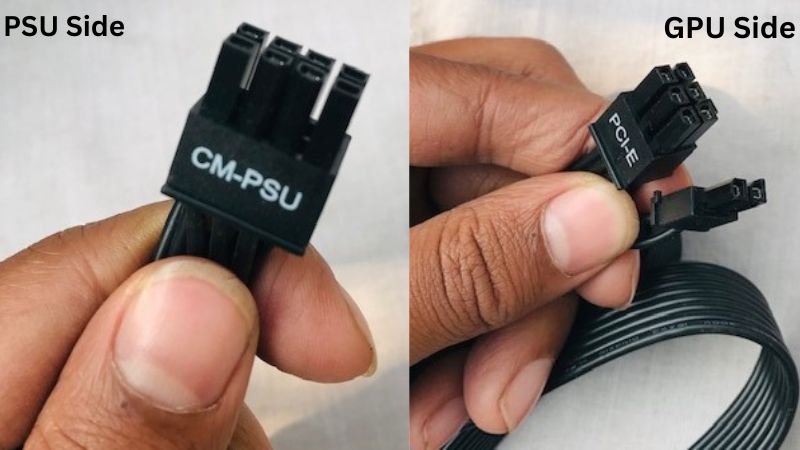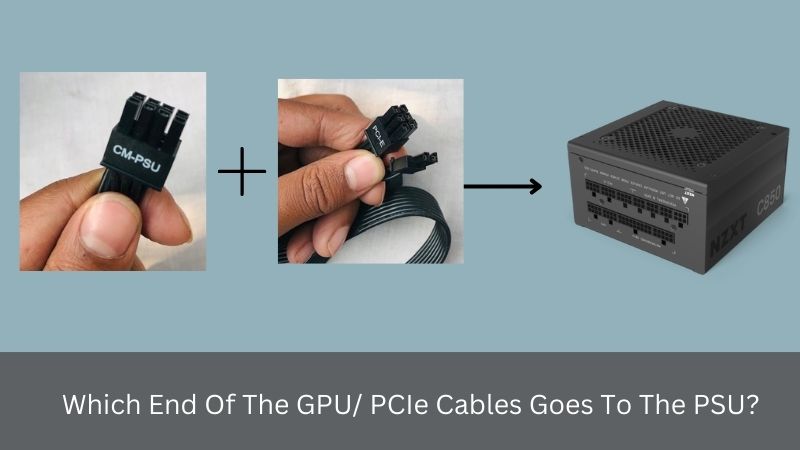If you are a novice PC builder and you have a modular or semi-modular PSU, then you may find it challenging to figure out which end of the PCIe cables goes to PSU and which end goes to the GPU.
Some modular or semi-modular PSUs have a larger connector side on one end and a smaller connector side on another end.
In such cases, the larger side connector will go to the graphics card & the smaller side will go into Power Supply.
However, some PCIe cables have the same size on both ends & if your PSU has this type of PCIe cable, then you can split the cables to figure out which end will go where.
The majority of the PCIe cables can be split into (6+2) pin configuration; this splittable side will go into the GPU, and the remaining side will go inside Power Supply.
If you still have doubts about which end of PCIe cables go where and where to connect the PCIe cables on the PSU, then keep reading this article till the end.
Understanding Of PCIe Connectors
The PCIe connectors draw power from the PSU and deliver that necessary power to GPU.
Some GPUs require a 6-pin PCIe cable, while some high-end GPUs require 8-pin PCIe cables.
The 6-pin and 8-pin PCIe connectors deliver different wattages of power; the 6-pin cable supplies 75W, whereas the 8-pin cable supplies 150W.
The PCIe cables are directional, which means the cables have a specific orientation in which you need to plug the cables.
You can determine the orientation in a couple of ways, and I outlined some of the ways below.
How To Identify Which Side Of PCIe Cables Go Where?
By checking the labeling and by splitting the PCIe cables, you can easily figure out the orientation of the PCIe cables.

Labeling On the Cable
My PCIe cable has the labeling on both sides; the CM-PSU indicates that this side of the cable will go to the PSU.
The PCIe indicates that this side of the cable will go on the GPU’s PCIe slot.
Split The Cables
If there is no labeling on your PCIe cable, then try to split the cable; the 6+2 splittable end will to the GPU, and the opposite end will go to the PSU.
Try To Insert The Cables
Sometimes PCIe cables only have six pins, so in that case, you can’t split the cable.
In such a situation, the only way to determine which end of the PCIe cables goes to the PSU is by attempting to install the cable.
Observe which end of the PCIe cables fits correctly and then plug the cable.
Where To Connect The PCIe Cables On PSU?
After finding the orientation of the PCIe cables, you need to check the connector side of your PSU.
Most of the time, the PSU abbreviates where to connect the PCIe cables; in my PSU, the labeling for this is 6+2 PCIe.

Additional Tips On How To Connect PCIe Cables
There are a couple of crucial factors you need to keep in your mind when plugging the PCIe cables-
Plug After Disconnecting the PSU
It is always advised to plug the PCIe cables into Power Supply after disconnecting the main power cord from the wall socket.
PCIe cables are not hot-swappable, which means it is not designed to be inserted or removed when the PSU is running.
If you install the PCIe cables this way, it can potentially damage your system’s hardware.
Connect The Cable On GPU First
It’s always better to plug the PCIe cable into the GPU side first to avoid any potential damage and prevent accidental disconnection to ensure stability.
Don’t Try To Plug The Cable Forcefully
Never try to put a lot of force on the PCIe cables because the cables are designed in a way that can easily be connected & disconnected.
Forcing a cable can damage the connector type on the cables and on the ports.
Check the cable’s orientation, align the cable with the slot, and plug it in properly.
Make Sure Cables Are Tighten
When plugging the PCIe cables into GPU or PSU, ensure that the cable is not loose.
If the cable is not attached firmly, then it can cause several issues, including- Power delivery issues, overheating, hardware damage, etc.
More Than One PCIe cable Can be required
You can clearly notice in the above image that the Power Supply has multiple ports for PCIe cables.
Because sometimes, there is a need to install multiple PCIe cables to supply power for the graphics card.
You have to figure out how many PCIe cables are required for your GPU, and you can do this by reading- one, two, or more PCIe cables for GPU.
Wrapping Up
The gist of the entire discussion is by checking the labeling on the cable, by splitting the cables, or by manually inserting the cable; you can check which end of the PCIe cables will go where.
If you have any other questions about the Power Supply or PCIe cables, you can comment below.
